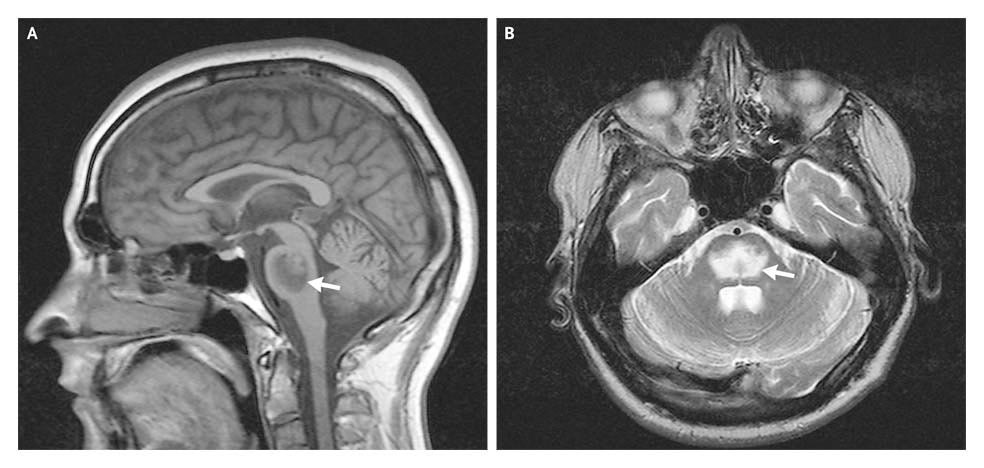Osmotic demyelination syndrome as a birth injury is very rare. It has happened to just a handful of pregnant women. But when you’re that “one in a million”, you want answers, even if they’re hard to find.
Below, we’ll shed some light on an obscure, but very important topic: how osmotic demyelination syndrome relates to pregnancy.

What is Osmotic Demyelination Syndrome?
Osmotic demyelination syndrome (ODS) is a rare neurological disorder. It involves the destruction of the protective covering (myelin sheath) of nerve cells in the brain’s white matter.
When it occurs in the pons area of the brain, it’s sometimes called Central Pontine Myelinolysis (CPM). The pons is an important brainstem structure that plays a crucial role in breathing, facial movements, and other functions.
The cause of ODS is almost always related to rapid changes in the body’s serum sodium levels, especially when sodium levels rise too quickly. It can result from various medical conditions and treatments, such as:
- Rapid correction of hyponatremia (low blood sodium levels)
- Liver disease and alcoholism
- Malnutrition
- Certain medical procedures, like liver transplantation.
Symptoms of ODS depend on various factors, including how severe the change in sodium levels was. Possible symptoms include:
- Muscle weakness
- Difficulty speaking or swallowing
- Behavioral changes
- Confusion
- Difficulty with coordination
- Coma or death (in severe cases)
Researchers have also uncovered a link between pregnancy and ODS. That means that osmotic demyelination syndrome can be considered a birth injury (in very rare cases). Stay with us to find out how ODS and pregnancy are related.

The Link Between Pregnancy and Osmotic Demyelination Syndrome
A 2021 study found that pregnancy can be a risk factor for osmotic demyelination syndrome. But pregnancy is far from being one of the main causes of this ODS.
However, pregnant and postpartum patients can have clinical features that suggest they’re susceptible to this disease. Those are the cases doctors need to keep a close eye on.
Also, when it’s related to pregnancy, the symptoms of ODS seem to appear gradually. This is different from most cases of ODS. For example, in cases of ODS where a doctor negligently raises the patient’s sodium levels too fast, the onset of symptoms is almost always quick.
A gradual onset of ODS symptoms isn’t “good news” per se, but it is “better news”. It means that doctors may have more time to detect ODS and treat the patient before irreparable brain damage takes place.
To prevent ODS as a birth injury, patients and their doctors should keep the following in mind:
- In pregnant women, central pontine myelinolysis can lead to serious problems for the mother’s health, and her ability to function normally.
- Pregnancy can cause severe morning sickness (hyperemesis). Uncontrolled vomiting can lead to electrolyte imbalance. So it’s important for doctors to notice any issues with fluids and salts in the body as soon as possible when dealing with hyperemesis.
- It’s also crucial to avoid prolonged periods of Hyponatremia (low sodium), and to avoid rapid correction of the same.

ODS as a Birth Injury: A Case Study
A 23-year-old woman who was 16 weeks pregnant was rushed to a hospital with alarming symptoms. She had been vomiting too much over the past three months. Her “morning sickness” was so bad that she had lost 15 pounds in one week!
The extreme weight loss was worrisome by itself. But she also showed signs of dehydration, like sunken eyes and pale skin.
Doctors took blood samples and discovered she had an electrolyte imbalance. She also had hyponatremia (low sodium levels). Doctors worked to correct her electrolyte levels, and she started to improve.
However, after a few days of treatment, the woman started having trouble walking. Her speech was slurred. Then she started to lose consciousness. After repeated brain scans, doctors diagnosed her with osmotic demyelination syndrome. They had to work fast to prevent brain damage from occurring.
Now for the happy ending to this story: Although she had to stay in the intensive care unit for 5 days, the woman was able to recover! Thanks to quick diagnosis and treatment, doctors prevented ODS from causing a birth injury.
Upon discharge, the only symptom she had was slow speech. She made a complete recovery. Later, she delivered her baby at term without any neurological issues.
Legal Help for Osmotic Demyelination Syndrome and Birth Injuries
Unfortunately, not all cases have “happy endings” like the one above. The sad truth is that doctors sometimes mishandle cases of osmotic demyelination syndrome in pregnant/postpartum women. Mishandling ODS is negligence. If that negligence causes a birth injury, it constitutes malpractice.
You may have the right to file a lawsuit concerning ODS. If you have any suspicion that foul play caused your injuries from ODS, please give us a call. We’ll help you understand whether you have a case, and what your legal options are.
FAQs: Understanding Osmotic Demyelination Syndrome
Usually, symptoms of osmotic demyelination syndrome set in about 2-6 days after abrupt correction of sodium levels. However, the exact timeframe for the development of ODS can vary from person to person. It can happen anytime from a few days to a few weeks after a dramatic rise in sodium has taken place. Remember, not everyone who experiences rapid changes in sodium levels will develop ODS. However the more quickly sodium correction occurs, the greater the likelihood that it will trigger ODS.
Yes, the effects of ODS can be permanent. But this isn’t always the case. The outcome depends on the severity of the case and the promptness of treatment.
Some people experience mild to moderate symptoms that improve over time with treatment and rehabilitation. But in more severe cases, or when ODS isn’t recognized and treated right away, it can lead to permanent neurological deficits.
A study published in 2020 found that the prognosis is favorable for people with ODs in general. But 1 in 6 patients had passed away within 6 months. Most of the patients who passed had underlying conditions, such as liver disease.
The prognosis is less favorable when ODS leads to profound neurological deficits and complications. Also, life expectancy can be reduced when ODS diminishes a person’s ability to perform daily activities (and overall quality of life).
Symptoms of ODS include confusion, difficulty speaking, muscle weakness, difficulty swallowing, movement disorders, and, in severe cases, paralysis, coma, or even death.
Osmotic demyelination syndrome is pretty rare, affecting middle-aged adults primarily, and often linked to rapid correction of hyponatremia (low sodium levels).
Recovery from osmotic demyelination syndrome (ODS) is possible, but the extent of recovery varies greatly from individual to individual. Treatment options are limited, and how likely you are to recover depends on a number of things, like the severity of the syndrome. But yes, it’s possible to recover.




